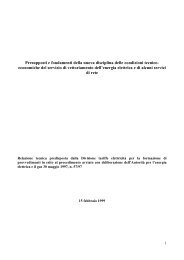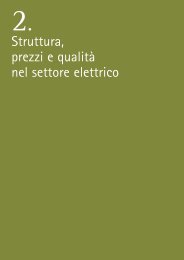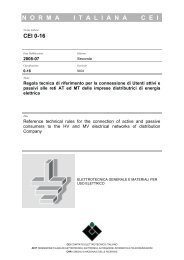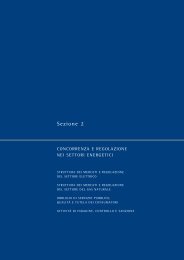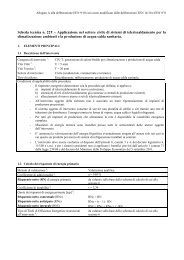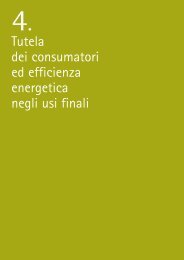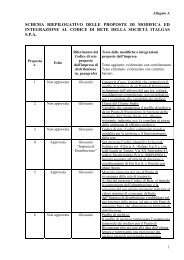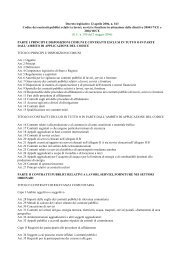Third Benchmarking Report on Quality of Electricity Supply
Third Benchmarking Report on Quality of Electricity Supply
Third Benchmarking Report on Quality of Electricity Supply
- No tags were found...
Create successful ePaper yourself
Turn your PDF publications into a flip-book with our unique Google optimized e-Paper software.
1.6.2 Rules for recording l<strong>on</strong>g interrupti<strong>on</strong>sIt clearly emerges from the survey that the majority <strong>of</strong> the regulators have not established orapproved rules for recording interrupti<strong>on</strong>s. There are <strong>on</strong>ly eight countries out <strong>of</strong> 20 surveyedwhere recording protocols are in place (Italy, Czech Republic, Norway, Portugal, Spain, Hungary,Great Britain, Sweden). These protocols address issues such as identificati<strong>on</strong> <strong>of</strong> interrupti<strong>on</strong>s,technology employed, assessment <strong>of</strong> the number <strong>of</strong> c<strong>on</strong>sumers affected, and definiti<strong>on</strong> <strong>of</strong> interrupti<strong>on</strong>causes (in general including that <strong>of</strong> force majeure). In Italy, Spain, Great Britain, Hungary,and Portugal the recording protocol was set by the regulator. In Norway the protocol (FASIT) wasdeveloped by a branch organizati<strong>on</strong> and is referred to by the regulator. Sweden has guidelines forthe calculati<strong>on</strong> <strong>of</strong> SAIDI and SAIFI.It is relevant to note that all the eight countries cited above have introduced standards and/or incentive/penaltiesregimes linked to the number and/or the durati<strong>on</strong> <strong>of</strong> l<strong>on</strong>g interrupti<strong>on</strong>s and/or energynot supplied. The rules for recording l<strong>on</strong>g interrupti<strong>on</strong>s are, in fact, the basis <strong>of</strong> these regulatory provisi<strong>on</strong>s:they ensure that all interrupti<strong>on</strong>s are recorded, and that the recording methodology is homogeneousacross the country. This enables a fair and correct implementati<strong>on</strong> <strong>of</strong> the financial incentiveschemes. Hence, it is <strong>of</strong> c<strong>on</strong>cern that Ireland, having adopted an incentive and penalty regimestates that no recording protocol has been implemented.Recording rules establish an obligati<strong>on</strong> for all (or at least all the major) companies to register c<strong>on</strong>tinuitydata. Sec<strong>on</strong>dly, they indicate which data are required for a correct identificati<strong>on</strong> <strong>of</strong> an incident.Usually these include the time interval <strong>of</strong> the supply interrupti<strong>on</strong>, its cause, the network device whereit originated, the affected installati<strong>on</strong>s and the number <strong>of</strong> c<strong>on</strong>sumers involved.One <strong>of</strong> the most relevant issues is the logging <strong>of</strong> incidents. Depending <strong>on</strong> the available technology<strong>on</strong> the network an incident is logged when i) a customer (or other pers<strong>on</strong>) first c<strong>on</strong>tacts thecompany to advise <strong>of</strong> no-supply, an abnormality or suspected abnormality; ii) there is an alarm <strong>on</strong>SCADA indicating a loss <strong>of</strong> supply, abnormality or suspected abnormality; or iii) an employee oragent identified the existence <strong>of</strong> a loss <strong>of</strong> supply, abnormality or suspected abnormality. There isusually no obligati<strong>on</strong> <strong>of</strong> automatic logging <strong>of</strong> the incidents, but, for instance, regulators in Italy andPortugal explicitly require companies to remotely c<strong>on</strong>trol the whole HV and MV distributi<strong>on</strong> networks(for each HV and MV feeder).A sec<strong>on</strong>d issue is the identificati<strong>on</strong> <strong>of</strong> the c<strong>on</strong>sumers affected by the interrupti<strong>on</strong>. Norway Portugaland Great Britain (see Additi<strong>on</strong>al Informati<strong>on</strong> 1.4) require companies to integrate the customerinformati<strong>on</strong> database with the topology <strong>of</strong> the network (c<strong>on</strong>nectivity model). At the present time Italy(see Additi<strong>on</strong>al Informati<strong>on</strong> 1.5) and Spain have rules for estimating the number <strong>of</strong> LV c<strong>on</strong>sumersinvolved in an interrupti<strong>on</strong>; however, both countries are requiring companies to be able to identifysingle customers in a few years time (in Spain the process is expected to be completed by 200611In Norway data recordings are referred to delivery points. A delivery point is a medium or high-voltage end-user or a distributi<strong>on</strong>transformer. In total 121 600 points.13<str<strong>on</strong>g>Third</str<strong>on</strong>g> <str<strong>on</strong>g>Benchmarking</str<strong>on</strong>g> <str<strong>on</strong>g>Report</str<strong>on</strong>g> <strong>on</strong> <strong>Quality</strong> <strong>of</strong> <strong>Electricity</strong> <strong>Supply</strong> – 2005 · Chapter 1





